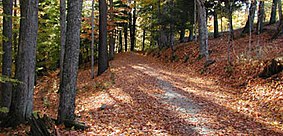George Perkins Marsh Boyhood Home | |
 | |
 | |
| Location | Marsh-Billings-Rockefeller National Historical Park, Woodstock, Vermont |
|---|---|
| Area | 40 acres (16 ha) |
| Built | 1805 |
| Architectural style | Queen Anne |
| Part of | Marsh-Billings-Rockefeller National Historical Park (ID03000282) |
| NRHP reference No. | 67000023 |
| Significant dates | |
| Added to NRHP | June 11, 1967[2] |
| Designated NHL | June 11, 1967[1] |
| Designated CP | August 26, 1992 |
| Marsh-Billings-Rockefeller National Historical Park | |
|---|---|
 Carriage road within the park | |
 | |
| Location | Windsor County, Vermont, United States |
| Nearest city | Woodstock, Vermont |
| Coordinates | 43°37′52″N 72°31′46″W / 43.6312462°N 72.5293562°W |
| Area | 643 acres (260 ha) |
| Established | August 26, 1992 |
| Visitors | 29,049 (in 2011)[3] |
| Governing body | National Park Service |
| Website | Marsh-Billings-Rockefeller National Historical Park |
| Interactive map | |
 | |
| Designated | August 26, 1992 |
| Reference no. | 03000282 |
The George Perkins Marsh Boyhood Home, also known as the Marsh-Billings House or Marsh-Billings-Rockefeller Mansion, is the architectural centerpiece of Marsh-Billings-Rockefeller National Historical Park, a National Historical Park in Woodstock, Vermont, United States. The house, built in 1805 and enlarged several times, is historically significant as the boyhood home of George Perkins Marsh (1801–1882), an early conservationist, and as the home later in the 19th century of Frederick H. Billings (1823–1890), a businessman and philanthropist who was a cofounder of the Northern Pacific Railroad. It is also architecturally significant as a high-quality example of Queen Anne architecture, alterations and enlargements commissioned by Billings and designed by Henry Hudson Holley. The house and its surrounding gardens were declared a National Historic Landmark in 1967.[4] The 550-acre (220 ha) estate on which it stands was given by Mary French Rockefeller (the granddaughter of Frederick Billings) and Laurance Rockefeller to the people of the United States in 1992.[5]
The park also preserves the site where Frederick Billings established a managed forest and a progressive dairy farm. The name honors Billings and the other owners of the property: George Perkins Marsh, Mary Montagu Billings French, Laurance Rockefeller, and Mary French Rockefeller.[6] The Rockefellers transferred the property to the federal government in 1992. It is the only unit of the United States National Park System in Vermont (except for a portion of the Appalachian Trail). The park was honored in 2020 by being placed on Vermont's America the Beautiful quarter.
- ^ "George Perkins Marsh Boyhood Home". National Historic Landmark summary listing. National Park Service. Archived from the original on December 22, 2008. Retrieved February 19, 2008.
- ^ "National Register Information System". National Register of Historic Places. National Park Service. January 23, 2007.
- ^ "National Park Service Visitor Use Statistics". National Park Service. Retrieved October 6, 2012.
- ^ Polly M. Rettig and John D. McDermott (May 26, 1967). "National Register of Historic Places Inventory-Nomination: Marsh-Billings House / George Perkins Marsh Boyhood Home" (pdf). National Park Service.
{{cite journal}}: Cite journal requires|journal=(help) and Accompanying three photos, exterior, from 1974 (32 KB) - ^ Diamant, Rolf. "Reflections on Environmental History with a Human Face: Experiences from a New National Park" (PDF). National Park Service. Retrieved March 11, 2015.
- ^ "Mary and Laurance Rockefellers' Billings Farm and the Farm & Museum". Vermont Standard. Archived from the original on December 25, 2014. Retrieved May 28, 2014.